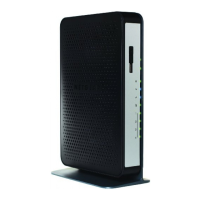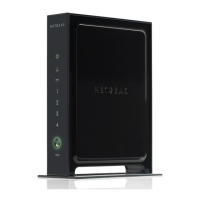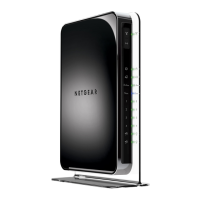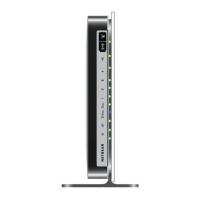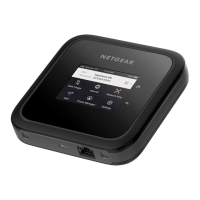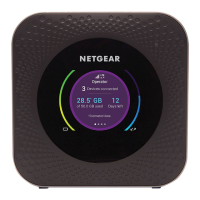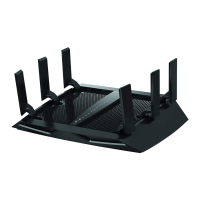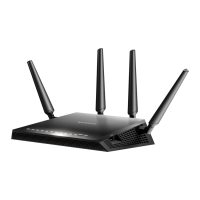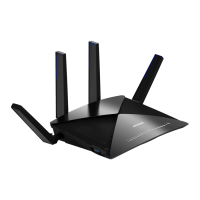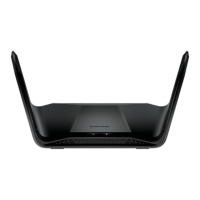Do you have a question about the NETGEAR N450 WNR2500 and is the answer not in the manual?
Overview of router parts, front/back panels, label, and optimal placement tips.
Instructions for connecting the router and verifying the setup via LEDs.
Gathering ISP info and preparing devices for the setup process.
Step-by-step guide to setting up the router using the genie software.
How to upgrade firmware and access the genie interface after setup.
Navigating the BASIC Home screen and changing the admin password.
Setting up password recovery and adding wireless devices.
Configuring the router's connection to the Internet Service Provider (ISP).
Setting up the wireless network name (SSID), security, and mode.
Viewing connected devices and controlling network access.
Configuring content filtering and internet usage restrictions.
Creating a separate wireless network for guests.
Using Setup Wizard and WPS Wizard for router configuration.
Accessing advanced configuration sections like WAN, LAN, and QoS.
Configuring Internet port settings, including DoS protection and MTU.
Configuring local network settings, including IP address and DHCP server.
Prioritizing network traffic for specific applications or devices.
Blocking access via keywords, ports, or schedules.
Configuring email alerts for security events.
Checking for and upgrading the router's firmware.
Viewing and configuring router activity logs.
Backing up, restoring, and erasing router settings.
Fine-tuning wireless network parameters and scheduling.
Configuring router as Access Point or in a Wireless Distribution System (WDS).
Understanding and configuring port forwarding, triggering, and DNS.
Configuring static routes and remote management access.
Setting up and configuring various IPv6 Internet connection types.
Monitoring and controlling internet traffic volume.
Viewing overall router status, information, and connection details.
Displaying and analyzing network traffic statistics.
Checking the status of wireless and guest network configurations.
Basic troubleshooting steps for common problems like restarts and connections.
Diagnosing problems by observing the router's LED indicators.
Resolving issues with router login, internet access, and wireless connections.
Using ping utility to test network path and connectivity.
Default router settings and detailed technical specifications.
Information on regulatory compliance, FCC, and EU directives.
Overview of router parts, front/back panels, label, and optimal placement tips.
Instructions for connecting the router and verifying the setup via LEDs.
Gathering ISP info and preparing devices for the setup process.
Step-by-step guide to setting up the router using the genie software.
How to upgrade firmware and access the genie interface after setup.
Navigating the BASIC Home screen and changing the admin password.
Setting up password recovery and adding wireless devices.
Configuring the router's connection to the Internet Service Provider (ISP).
Setting up the wireless network name (SSID), security, and mode.
Viewing connected devices and controlling network access.
Configuring content filtering and internet usage restrictions.
Creating a separate wireless network for guests.
Using Setup Wizard and WPS Wizard for router configuration.
Accessing advanced configuration sections like WAN, LAN, and QoS.
Configuring Internet port settings, including DoS protection and MTU.
Configuring local network settings, including IP address and DHCP server.
Prioritizing network traffic for specific applications or devices.
Blocking access via keywords, ports, or schedules.
Configuring email alerts for security events.
Checking for and upgrading the router's firmware.
Viewing and configuring router activity logs.
Backing up, restoring, and erasing router settings.
Fine-tuning wireless network parameters and scheduling.
Configuring router as Access Point or in a Wireless Distribution System (WDS).
Understanding and configuring port forwarding, triggering, and DNS.
Configuring static routes and remote management access.
Setting up and configuring various IPv6 Internet connection types.
Monitoring and controlling internet traffic volume.
Viewing overall router status, information, and connection details.
Displaying and analyzing network traffic statistics.
Checking the status of wireless and guest network configurations.
Basic troubleshooting steps for common problems like restarts and connections.
Diagnosing problems by observing the router's LED indicators.
Resolving issues with router login, internet access, and wireless connections.
Using ping utility to test network path and connectivity.
Default router settings and detailed technical specifications.
Information on regulatory compliance, FCC, and EU directives.
| Brand | NETGEAR |
|---|---|
| Model | N450 WNR2500 |
| Category | Wireless Router |
| Language | English |
